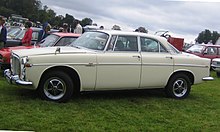Rover P5
| rover | |
|---|---|
|
Rover P5B sedan
|
|
| P5 | |
| Sales designation: | Rover 3-liter Rover 3 1/2-liter |
| Production period: | 1958-1973 |
| Class : | upper middle class |
| Body versions : | limousine |
| Engines: |
Petrol engines : 3.0-3.5 liters (94-116 kW) |
| Length: | 4737 mm |
| Width: | 1778 mm |
| Height: | 1473-1549 mm |
| Wheelbase : | 2807 mm |
| Empty weight : | -1587 kg |
| Previous model | Rover P4 |
| successor | Rover P6 |

The Rover P5 , also called 3-liter or 3 1/2-liter depending on the displacement , was a four-door sedan of the upper middle class or a so-called four - door coupé (with a lowered roof), which were produced from 1958 to 1973. The car, also known as the "middle class Rolls-Royce", was very popular with government employees. Even Queen Elizabeth II is said to have loved driving her Rover P5. During the Chancellorship of Bruno Kreisky , the P5 was also the official car of the Austrian Federal Chancellor.
Mark I.
The P5 appeared in 1958. As it was powered by an engine with 2995 cm³ displacement and 128 bhp (94 kW), it was soon called "3-liter". The 6-cylinder in-line engine had an IOE valve control : overhead intake valves and side exhaust valves (hence "oise" = overhead inlet / side exhaust), an arrangement that was already used in the P4 engine. Some early P5's had drum brakes on the front, but most had booster disc brakes. On request, a Borg-Warner 35 automatic transmission and power steering could be ordered. The Mark Ia model had triangular windows in the front doors from 1961. In 1962 the first series was discontinued after 20,963 copies.
Mark II
The Mark II version of the P5 was introduced in 1962. It had a more powerful engine (129 bhp / 95 kW, also from 3 l displacement) and improved wheel suspensions. The most interesting innovation, however, was the additionally available coupé. This four-door version had a lower roof and narrower B-pillars, which gave it the appearance of a hardtop coupé. Until the model series was replaced in 1965, 5,482 coupes and 15,676 sedans were produced.
Mark III
The more modern looking Mark III was introduced in 1965. It was also available in both body versions (sedan and coupé). The engine also remained largely the same, but now 134 bhp (99 kW). 3919 sedans and 2501 coupes were produced by the end of production in 1967.
P5B
The last offshoot of the P5 appeared in 1967. Since it had the Rover V8 engine with 3528 cm³ displacement and 158 bhp (116 kW) (as in the P6 since 1968 ), it was soon called "3 1/2-liter" .
The letter "B" stands for Buick , since the basis of this engine was first used in the USA since 1960 in the Buick Special and in the Oldsmobile F-85 and Pontiac Tempest . Production there had already been discontinued in 1963 because these so-called compact cars were considered too small there. Since the aluminum engine was very light and fit into the more modern P6 , Rover had acquired the rights from General Motors in 1964 . In order to meet European requirements, it was further developed by the designer Joe Turley, who had been hired by Buick, and English engineers: The casting process (from permanent mold to sand casting ), the ignition system and the mixture preparation (from twin carburettors to two SU carburettors ) were changed and the engine speed was fixed . How well the development department at Rover has worked is also shown by the fact that this V8 was built for well over 30 years - up to the 4.6 liter engine in the Range Rover and also the largest at sports car manufacturers such as Morgan and TVR Enjoyed popularity.
With the new engine, the P5 was 123 kg lighter; its consumption decreased by more than 20%. In addition to power steering, an automatic transmission was part of the basic equipment because no mechanical transmission was available in Great Britain that could withstand the 270 Nm torque that the engine developed from 2500 rpm.
The exterior of the vehicle was unchanged, with the exception of the 3.5 liter badge, bumper horns and a pair of fog lamps that were placed under the main headlights that gave the car a 4-head front view. The P5B was also offered as a four-door sedan and a four-door coupé until the end of production. 9099 coupés and 11501 sedans were built by the end of the P5 series in 1973.
The last copies of the P5B to leave the factory were reserved for government use. In fact, these vehicles were used in Westminster for more than 10 years . Prime Ministers Harold Wilson , Edward Heath and James Callaghan used this car as their official car. Only Margaret Thatcher rose to a Jaguar XJ to.
Today, the P5 series cars are coveted collector's items. The sportier and rarer coupé versions are considered the most popular objects.
A wine-red copy can be seen in the biographical film The Life and Death of Peter Sellers .
In the British film A Man Chases Himself from 1970, Roger Moore drives an also maroon P5B.
Conversions
The French coachbuilder Chapron built a two-door convertible based on a Mark I in 1962. The car was shown to the public at the Paris Motor Show in October 1962. A planned production in small series did not materialize. Chapron's P5 Cabriolet remained a one-off.
Web links
Individual evidence
- ↑ on this and on the following Heiner Buchinger: Rover V8 Story, Roverblatt, p. 17f
- ↑ Entry in the imdb
- ^ Dominique Pagneux : Henri Chapron. Carrosserie française , ETAI, Boulogne-Billancourt, 2002, ISBN 2-7268-8602-7 , p. 182.


